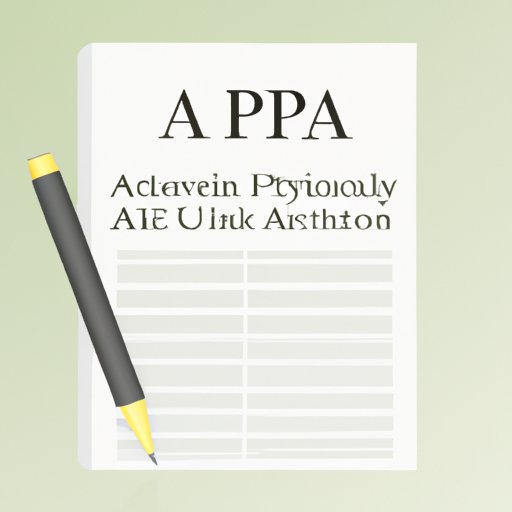
I. Introduction
When writing academic papers, citations are an essential component of effectively and responsibly incorporating other authors’ ideas and research into your own work. Citations provide credibility and support for your arguments, ensure academic honesty, and allow readers to trace your sources and build upon your work. One of the most important and commonly used citation styles is APA (American Psychological Association), which requires both in-text citations and a reference list at the end of the paper. This comprehensive guide will provide step-by-step instructions on how to properly cite sources in APA style in-text, address common pitfalls to avoid, and provide examples and tips to help improve citation accuracy.
II. A Step-by-Step Guide: How to Cite In-Text using APA Style
In-text citations are used to briefly identify the source of information you have paraphrased or quoted within the text of your paper. They allow readers to easily connect the source’s author and publication year to specific information you have included in your writing. Here’s a step-by-step guide on how to format in-text citations in APA style:
1. Identify what kind of source you are using (e.g., book, journal article, webpage).
2. Determine the relevant citation information, such as author name(s), publication date, and page number(s).
3. Choose the appropriate citation style based on whether you are paraphrasing or directly quoting the source.
4. Insert the citation information within your writing at the appropriate point, using parentheses to enclose the citation information.
5. If you are directly quoting the source, include the page number in your citation.
Example of a correctly formatted in-text citation for a paraphrased source:
According to Jones (2019), effective communication is crucial in the workplace.
Example of a correctly formatted in-text citation for a direct quote:
“Effective communication is crucial in the workplace” (Jones, 2019, p. 43).
III. The Basics of APA In-Text Citations: Tips and Examples
While APA in-text citations include some specific rules and formatting requirements, they are generally straightforward and easy to follow. Here are some basic tips and examples:
– Formatting author names:
For one or two authors, include both names in your citation. For three or more authors, list only the first author followed by “et al.” (meaning “and others”).
Example:
– One author: (Smith, 2020)
– Two authors: (Smith & Jones, 2020)
– Three or more authors: (Smith et al., 2020)
– Formatting dates:
Include the year of publication, and place it in parentheses after the author(s).
Example: (Smith, 2020)
– Formatting page numbers:
When directly quoting, include the page number(s) in your citation after the year of publication.
Example: (Smith, 2020, p. 43)
Example of a correctly formatted in-text citation for a journal article:
According to Kim and Lee (2018), “positive psychology interventions can improve psychological and physical well-being for both healthy and pathology groups” (p. 38).
Example of a correctly formatted in-text citation for a book:
Recent research has demonstrated that “several regions in the brain, including the hippocampus and prefrontal cortex, are involved in spatial navigation” (Ekstrom, 2018, p. 60).
IV. Overcoming Common Pitfalls: Mastering APA In-Text Citations
While APA in-text citations are generally straightforward, there are some common mistakes that writers make when formatting their citations. To help improve citation accuracy, here are some strategies for avoiding common pitfalls:
– Be sure to include all necessary citation information, including author name(s), publication date, and page number(s).
– Double-check that your citations match the sources listed in your reference list.
– Pay close attention to the formatting requirements for different types of sources.
Example of an incorrectly formatted in-text citation:
According to Smith, “effective communication is key” (2019).
Problem: This author’s last name is not sufficient to identify the source in the reference list. The year of publication and page number must be included.
Example of a corrected in-text citation:
According to Smith (2019), “effective communication is key” (p. 28).
V. In-Text Citations Made Easy: A Beginner’s Guide to APA Style
If you’re new to APA style, in-text citations can seem overwhelming at first. Here are some tips and tricks to make the process easier:
– Familiarize yourself with the basic formatting rules and use citation tools to help you format your citations correctly.
– Focus on the information required for each type of source, such as author name(s), publication date, and page number(s).
– Practice, practice, practice. The more you write using APA style, the easier it will become to format your in-text citations correctly.
VI. The Do’s and Don’ts of APA In-Text Citations: Everything You Need to Know
Here are some essential do’s and don’ts for APA in-text citations:
– DO use direct quotes sparingly and make sure to integrate them smoothly into your writing.
– DON’T include long quotes that disrupt the flow of your writing or take up too much space on the page.
– DO include page numbers for all direct quotes.
– DON’T forget to include the year of publication for all sources cited in-text.
– DO use sources to support and enhance your writing, but make sure to properly credit their ideas and information.
– DON’T plagiarize. Always properly cite your sources and give credit where credit is due.
Example of a well-integrated source:
According to Jones and Smith (2020), “the ability to work collaboratively is crucial for success in the workplace, as it fosters creativity and innovation” (p. 14).
VII. Conclusion
Proper in-text citation is essential when it comes to academic writing. APA in-text citations provide credibility, ensure academic honesty, and allow readers to trace your sources and build upon your work. From understanding the basic formatting rules to avoiding common pitfalls and mastering the citation process, this comprehensive guide has provided a wealth of information and examples to help improve citation accuracy. By applying what you have learned, you can ensure that your writing is well-supported, trustworthy, and academically sound.





